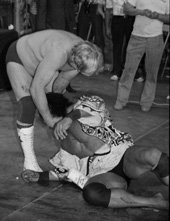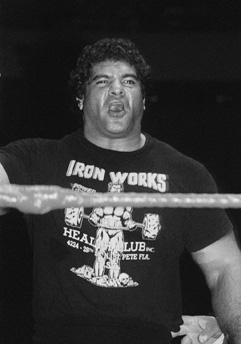

Donnybrooks, slobberknockers, or pier six brawls: whatever they’re called, fans know they will be wild and exciting.
The origins of the term “pier six brawl” remain in doubt, but announcer Gordon Solie is widely acknowledged as the man who made the phrase synonymous with professional wrestling.
Pull-apart battles are a great way to show just how much two men hate each other — wrestlers begin brawling and continue until referees and/or other officials try to break up the action. Usually, someone will break free and attack again, restarting the whole process.
Wrestling has had so many wild brawls it’s difficult to choose the best. What follows are some of the most memorable from the last thirty years — brawls that are still talked about by grapplers and fans alike.
Mention the Tupelo Concession Stand Brawl and people are probably going to give you several different accounts. It’s not a case of fuzzy memory syndrome — it’s just that people are prone to remember variations on the angle they’ve seen over the years. The Tupelo Concession Stand Brawl has become almost mythical, and promoters have revisited it on countless occassions.
The event occured after a match between the team of Jerry Lawler and “Superstar” Bill Dundee and the Blonde Bombers (Wayne Ferris and Larry Latham). The Bombers upset the veterans for the tag team championship. A post-match donnybrook spilled into the back of the arena near a concession stand, and history was made.
It didn’t take long for it to become the stuff of legend. In 1981, Eddie Gilbert wanted to recreate the brawl during a run in CWA. The 1981 encounter saw Masa Fuchi and Mr. Onita battle Gilbert and Ricky Morton. This brawl was equally memorable, and some fans even prefer it to the original. Even the promoter became involved.
Many wrestling historians cite the Concession Brawl as the origin of hardcore style. The truth is, wrestling had always had its share of moments that would later be called “hardcore.” The difference is that earlier generations of promoters used these things sparingly to preserve their novelty — and to cut down on injuries, too.
The angle would be revisited many times over the next three decades, including a 1995 pay-per-view match between Harlem Heat and Nasty Boys. Other favorite versions of the match include the 1992 USWA bout between the Moondogs and the team of Jerry Lawler and Jeff Jarrett.
As exciting as Barry Windham’s heel turn was, it paled compared to what happened next. The not-so-mysterious Midnight Rider confronted Windham after he’d betrayed “The Total Package” Lex Lugar against Arn Anderson and Tully Blanchard. But there was one small problem: the masked man had done it in the heel locker room. An army of bad guys pounced, grabbing at the Rider’s mask. The scene ended with J.J. Dillon admonishing a cameraman, telling him to chase after the hooded wrestler as he was spirited out of the dressing room by his baby-face allies. . . .
The story actually began much earlier, when fans welcomed Magnum T.A. back to JCP. After months spent recovering from a terrible automobile accident, Terry Allen was once again in front of the camera (albeit not as a wrestler). When the Four Horsemen’s Tully Blanchard put his hands on Magnum, Dusty Rhodes went berserk and attacked. In the mélee, the American Dream assaulted an NWA official, and for that, he was promptly banned from wrestling.
When the hooded Midnight Rider soon emerged, the Horsemen cried foul. Earlier in his career Rhodes had been accused of using this persona when a similar similar situation in CWF also resulted in a ban. The heels of JCP were certain Rhodes had returned to an old identity to get around his latest suspension.
Around the same time, James J. Dillon warned a babyface Barry Windham that Lex Luger would leave him hanging one day. Windham took the words to heart, and ultimately decided to strike first. During a tag team title defense against Arn Anderson and Tully Blanchard, Windham found himself wrestling most of the match alone while Luger lay incapacitated outside the ring. Eventually, Lex crawled back in, barely conscious. When a frustrated Windham finally reached him for a tag, a confused Lex promptly powerslammed his partner. In retaliation, Windham gave the Total Package a lariat. Windham’s attack flattened Luger, leaving him at the mercy of Anderson and Blanchard. The Horsemen capitalized, and Arn Anderson scored the pinfall regain the NWA world tag team championship.
As Sting, Steve Williams, and Nikita Koloff checked on Lex, the Midnight Rider stormed into the dressing room area. He confronted Windham, asking him to account for himself, but he was ignored. The newest member of the Horsemen told Rhodes — I mean, the Rider — that he had nothing to say to him and turned to leave.
As Windham walked away, reality dawned. The Midnight Rider was surrounded by over a dozen heels, many of whom held deep-seated grudges against the man they believed was underneath the hood. For a moment time stood still, then the Rider began throwing punches. The odds, however, were just too overwhelming. The Rider quickly went down as Ric Flair screamed, “Get the hood.” The wrestlers ripped at the mask and in seconds it was off. Now, they just had to get a cameraman to show the Rider’s face to the world . . .
Before that could happen, however, Williams, Sting, and Koloff raced in, attacking the heels, and more importantly, covering their friend from view. The three wrestlers formed a human cocoon around the Rider, ushering him out of the dressing room as J.J. Dillon howled. All the cameras managed to catch was a swirl of blond hair.
Don Muraco is best known as “Magnificent Muraco,” but his self-proclaimed title, “The Prince of Darkness,” was a far more appropriate monicker: it described the dark heart at his core. This became clear when Muraco appeared on “Buddy Rogers Corner” and began spewing venom about opponents such as Tito Santana, Rocky Johnson, and WWF champion Bob Backlund. Muraco boasted that he was the first man to reverse the figure-four leglock and praised his own defense of the Intercontinental Championship. He continued ranting until the fans erupted. They were cheering, but not for Muraco (who the fans loved to deride as “Beach Bum”). It was the arrival of Jimmy “Superfly” Snuka that caused the stir.
Snuka had become one of the hottest stars in the WWF after turning babyface when Buddy Rogers uncovered the fact that Snuka’s manager Lou Albano had been robbing him blind. When Snuka confronted Albano, he was waylaid by Ray “The Crippler” Stevens and piledrived two times onto the concrete floor. By the time Snuka returned from his storyline injury, fans were solidly behind him.
An insulted and enraged Muraco approached the ring and glared at Snuka, whose only reply was a smile. WWF announcer Vince McMahon confidently predicted Snuka would not lose his cool, but he was soon proven wrong when Muraco walked up to the mat apron and spit at the Superfly. Muraco jumped off the mat apron and celebrated his misdeed. Snuka dove over the top rope onto Muraco, flattening him. Then, the Superfly tore off Muraco’s sports coat and pounded him in the face.
Clearly, Snuka had lost his cool. He continued tearing into Muraco, tearing off his shirt and eventually ripping his pants to reveal his wrestling trunks. As Muraco flailed around on the arena floor, several preliminary wrestlers ran out to try and restrain Snuka. As they did, Muraco rolled into the ring and grabbed a microphone. When he rolled back out, he swung it at Snuka (who was still being held by the other wrestlers).
After taking his cheap shot, Muraco continued to rain down blows, his tattered clothes flying about him. More wrestlers emerged and attempted to restrain both men, but the task seemed impossible. They were that determined to get at each other, one way or another. Snuka broke free momentarily, getting a few blows in on Muraco before the swarm of wrestlers finally managed to separate the combatants.
The incident launched a red-hot feud, with Snuka battling Muraco both for revenge and the Intercontinental belt. The two would meet in several inconclusive bouts until a cage match was signed for Madison Square Garden. Just as he had done during his earlier match against Bob Backlund, Snuka performed his Superfly death dive off the top of the cage.

“The Prince of Darkness” Don Muraco